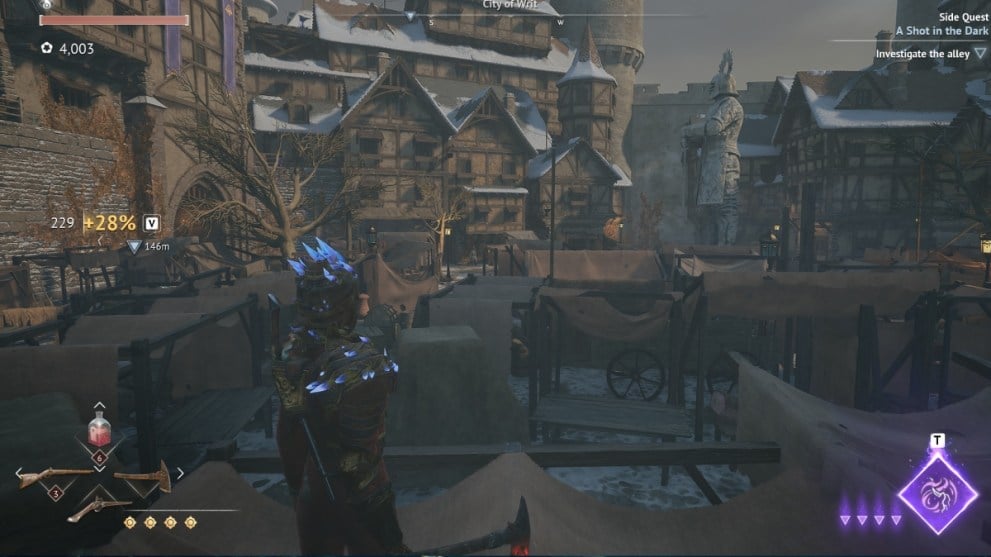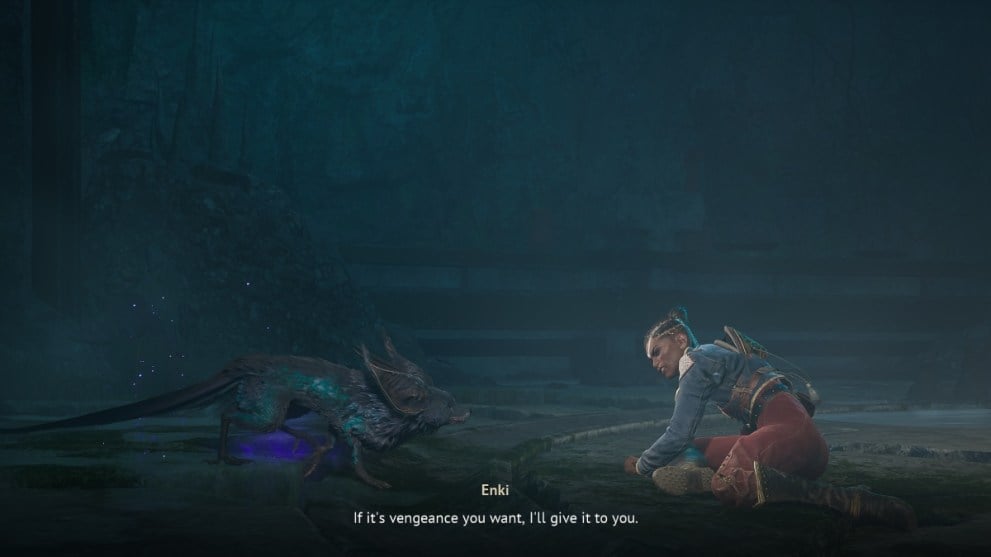Flintlock: The Siege of Dawn on PC
For the most part, Flintlock The Siege of Dawn is an excellent game. However, there are a few setbacks that hamper the experience and its ability to reach the heights I’m sure it could.
To start off, I would describe this game as Remnant-esque, with more focus on the melee combat rather than just firearms. The combat plays quite similarly and your close-range mobility options and dodging options also feel similar. I’d say that the bosses feel the same as well, but there are some key differences I’ll get into later. The point is, if you loved the Remnant games and want more of that, Flintlock The Siege of Dawn delivers a very solid and similar experience.

Before getting into my praise for the game and talking about everything I loved, some performance issues make me hesitate outright recommending the game in its current state. I’m playing on an RTX 3070, which should be well above the recommended requirements, however, the frame stutters I experienced in the latter half of the game were jarring, to say the least.
They pop up on random occasions as you load into a new area or even during combat, and last for several seconds, making for an extremely frustrating experience. I’m normally not someone who complains about some frame drops here and there, nor do I demand a perfect 120fps experience, but they were noticeable enough that I feel it’s mandatory to mention them. I’d say that, in its current state, these performance issues are the game’s biggest weakness, and I hope the developers are able to fix them before launch.

I would find this acceptable if not for one other glaring issue that I was shocked to learn about. The in-game display settings are incredibly barebones and give you no options to manage textures, lighting, or shadow quality to improve the game’s performance. As far as performance goes, you are at the developer’s mercy for now. I really do hope they add more options before launch, otherwise it will be incredibly frustrating for many players who would otherwise enjoy this game.

Beyond the performance issues and getting into the actual meat and bones of the game, we have a very solid adventure following our guilt-ridden protagonist Nor, a Sapper, and her companion Enki, who are on a quest to kill the Gods that have risen from the underworld and invaded the human world with their legions of the dead.
There is enough diversity in the two main regions where you go along rivers, across mountains, through caves, cities, swamps, and all sorts of different vistas that keep the atmosphere fresh. There was care put into making every biome and region feel unique as you progress through this 20-30 hour story.
The story itself is pretty straightforward, with a bunch of side quests and companion quests sprinkled in for flavour. To their credit, the side quests are well thought out and feel unique, and the companion quests are all accompanied by some great voice acting from the entire cast, which makes the whole setting feel a lot more real. You’ll also find a ton of NPCs playing the Sebo board game around the world, Witcher 3 Gwent-style, which was quite funny considering the ridiculous locations you could sometimes find them in. However, personally, the Sebo AI got way too good for me to handle at a certain point.

As for the exploration, the verticality and expansiveness of this game can honestly feel refreshing when you start because the game eases you into its fairly large and expansive open world with branching optional paths. The movement is also designed in a fun and intuitive way, with shortcut unlocks feeling very satisfactory whenever you reach them.
There is a ton of verticality to the game, complimented by the aforementioned movement, and it makes you want to explore every nook and cranny for hidden paths and grabbable ledges because it generally leads to a new piece of armor, weapon, or grenade, which always feel good to find.
The core gameplay revolves around the usage of your melee weapon for attacking and parrying, and your pistol that’s used to interrupt unblockable attacks. Melee attacks give back charges for your pistol, so you’re always going to be using a mix of both. This makes for a great balance choice as you can’t play too aggressively or too passively, forcing you to get into the game’s rhythm and learn how the flow of combat works. The pitfall here is that some enemies and janky hitboxes completely mess up the flow the game is trying to create, but when it works and you get into the zone, it’s an incredibly satisfying and rewarding experience.

On top of the basic combat, you’ll have three skill trees to upgrade your firearms, melee weapon, and Enki’s curses for critical damage. Add grenades and sidearms such as snipers and flamethrowers on top of this, and you have a pretty diverse arsenal at your disposal that keeps the game fresh. Of course, there’s variety in the melee and pistol weapons too. My only primary issue with those is how tedious it feels to upgrade them due to the incredibly steep Reputation (basic currency) cost associated with them. This cost almost always makes you gravitate towards skill upgrades or focusing on weapons that don’t require Reputation.
It’s a shame because that means the game is actively disincentivizing you from trying out multiple weapons and armor. While the Reputation gains in the game are balanced, considering the fact that you become quite overpowered after investing in a bunch of skills, I feel as though the Reputation requirements for the weapon upgrades need to be reduced because there is no new game plus and you won’t get to experience all the weapons in a single run. That is a shame because some of them seem very cool and have a distinct feeling to them.
Speaking of weapons and armor, I would like to comment on the limited number available. By the end of the game, I discovered six pistols, six melee weapons, four grenades, and six secondary range weapons. There were around five armor sets, three different Enki Shards, and five different Witherings. While this sounds like a lot, and I honestly really enjoyed the well-thought-out passives and playstyles meant for each of these. It made me wish that there were more of them to find and collect. Unfortunately, more weapons would make me feel even worse about how limited the Reputation to upgrade them is.

However, this system makes sense with how much skills and equipment change your playstyle and truly make you feel overpowered. Hordes you struggled with before become rabble and even late-game enemies are no match for a well-built Sapper.
The explosiveness of combat at this point combined with your mastery over the system makes for an incredibly satisfying experience that makes you desire more and more challenge. However, this is also where the game lets you down. Despite all these well-built systems and power-ups in place, I believe Flintlock: The Siege of Dawn fails to truly challenge you. Let me explain.
Near the start of the game, I ran into a Stone Golem boss which took me several dozen tries to defeat as I learned all of its moves and patterns in an incredibly Soulslike fashion. Facing this boss sent me into a zone where I would be completely focused on this epic fight in front of me.
However, such bosses are rare and far between in Flintlock and that is one of its biggest weaknesses. The mini-bosses and bandit leaders feel a bit lazy and only two out of the four Gods we fight fall into the category of a back-and-forth battle of flow and rhythm. I feel like this is a missed opportunity for some well-designed and memorable bosses that would have elevated how memorable this game was.

You can turn up the difficulty, but it doesn’t change the fundamental issue with some enemy move sets and variety. Most enemies follow a fairly straightforward sequence of attacks, for example, after a certain point, you know that every enemy’s first attack always tends to be an unblockable one. The AI could use a bit of improvement and some more enemy variety would really help the final leg of the game. Also, whoever designed the bird enemies needs to pay for their crimes, but that’s just my opinion.
All in all, if you’re looking for a more casual version of Remnant or a more accessible soulslike with a well-thought-out open world and a fairly sympathetic cast of characters, then Flintlock: The Siege of Dawn will be a satisfying experience. However, if you’re looking for something that poses a truly difficult challenge filled with epic bosses, you might want to pass or at least wait until they sort out all the performance issues. I had a fairly good experience with the game, and some improvements on this well-laid-out base could result in a truly amazing game. Perhaps we’ll see those in a potential sequel, which I would definitely be willing to try out.
- Satisfying and challenging combat
- World feels alive and dynamic
- Secrets around every corner for completionists
- Performance issues
- Boss designs leave more to be desired
- Some hidden rewards feel way too repetitive and insignificant
- Weapon upgrade system could use some tweaking













Updated: Jul 17, 2024 06:19 am